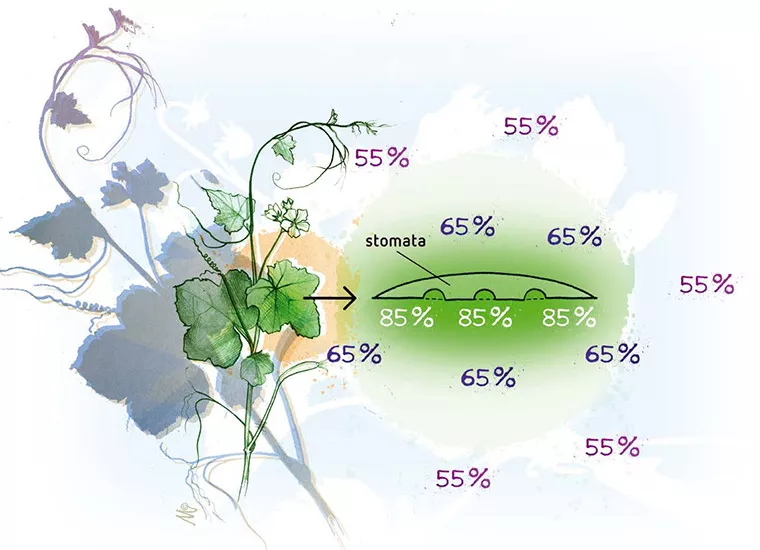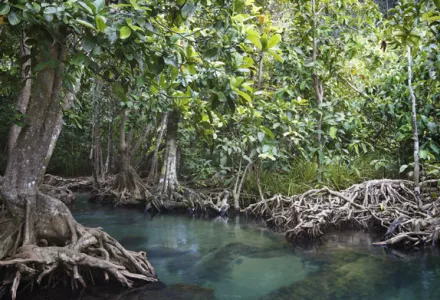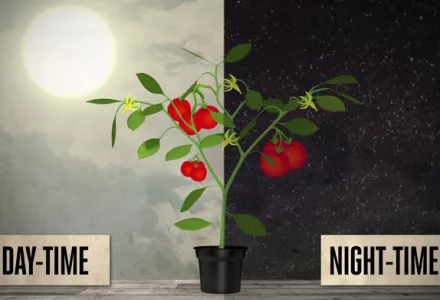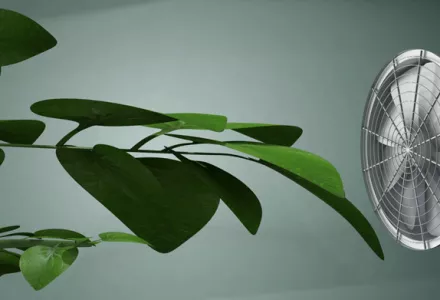They're funny old things, plants. surviving on a completely different set of rules than animals, it's sometimes hard to fathom exactly what it is that makes them tick. All too common a mistake for a gardener is to focus on their (more-often-than-not rather excessive) feeding regime, looking for some sort of magic in a bottle to make things right.
It's hard to argue with some marketing, "Doubles your yield right? Says it right there on the bottle plain as day. I'll take three please good sir!"
The more savvy or seasoned gardeners out there will know through experience (or having fallen folly to such claims) that a plant needs attention in areas other than just what bottle of feed can provide. The immediate environment around the plant is something that if properly controlled, will give you more benefit than any bottle of jazz you can frantically pour into your reservoir.
We're not just talking about the immediate environment around the leaves either. Granted, that is the most obvious place to start looking, but you will need to go deeper than that to gain complete control of things. The roots of a plant also have their own immediate environment to cope with (that of the substrate) so you will need to become a master of the unseen. Balancing the conditions above and below ground is the name of the game here, and the prize? A harmonious harvest.
Above Ground
So let's start with the above ground bit. How exactly do the different variables in the conditions of the air impact a plant? Well, it essentially all boils down to the stomata on a leaf and what they do in different environment conditions. They are a key feature in a plant. Understanding how they react to changing environments is the goal of the day here.
Most gardeners are aware of these being responsible for the plant being able to photosynthesize. They open during the day to let in CO2, allowing for the production of energy via photosynthesis. That is a small part of the story though! The larger part of the story is that it needs to cool itself from associated daytime heat, coming from both the ambient air temperature and infrared (IR) heat from the light source. This is all done via little pores on the leaves called stomata. They don't just open to a set amount, stay like that, and then shut themselves up again for a good snooze overnight though. They are in constant flux the entire day, opening and closing different amounts in response to what is happening with the plant as a whole, and how the following factors may have effected them.

Light
Light plays an important part for many processes in a plant, too many to go into for this article. What you need to bear in mind here is that as well as triggering and influencing the rate of photosynthesis (the more photons of light available per second, the higher the photosynthetic potential), light generates heat (particularly in the form of infrared) which the plant both makes use of (to speed up the assimilation process) but also needs to mitigate against which it does by opening up its stomata, in order to transpire more. At night-time (or lights off) the stomata close, where-as in daytime (or when lights turn on) they will open to varying degrees, partly dependent on the amount of light they receive over time.
As a general rule, if you half the amount of light (dim ballasts down to 50% or turn half of your lights off) you will reduce the amount of transpiration that is occurring as less heat is generated. However it will also reduce the amount of energy being produced through photosynthesis by a relative amount. So, ideally, it is best left as a last-resort scenario. For example, in an indoor grow room, at the end of a particularly hot and dry day, it can often be the easier solution in a grow room to limit light intensity when the plant has suffered from extreme water loss throughout the day. Outdoors, this is likely to be in the middle of the day, where sun screening may become necessary.
Temperature
Temperature has a direct impact on the stomata of a plant. The higher the air temperature (or amount of infrared in the light spectrum) the more the plant will need to transpire in order to cool itself down to an ideal temperature (and also from the knock on effect a raise in temperature has on humidity).
The hotter the plant is, the more it needs to cool itself. The more it needs to cool itself, the wider the stomata will open. The wider the stomata open, the more it can transpire and cool itself. The vast majority of the water your plant consumes during its life is used to cool itself. Ninety-nine percent is lost to transpiration, leaving only 1% for other processes, including photosynthesis!
Guidelines on particular temperatures to maintain obviously vary depending on what the ultimate goal is with whichever species of plant you will be growing. Ideal temperatures can also vary with changes in environmental factors, such as supplementing CO2. As a general rule, you want to consider what is happening with your temperatures over an average 24 hour period. The temperature differences you can create between the day and night period around this average can then be used to impact how the plant uses its energy.
With no temperature difference (Diff = 0. Example: 82F in the day and night time period), the plant will naturally steer the energy produced during photosynthesis into vegetative growth (new leaves and shoots). Having a larger temperature difference (Diff = 14 degrees F. Example: 82F when lights are on down to 68F when lights are off) will encourage that energy to go into the production of flowers/fruits/seeds. So as a rule of thumb, stick to a smaller difference during vegetative growth and a larger difference during the flowering period. It is worth noting that at higher temperatures, all metabolic processes (like photosynthesis) happen at a faster rate. So more photosynthesis, and therefore energy production, is possible at higher temperatures, but of course not if it is so high a temperature that the plant can no longer cope with cooling itself. Also, temperature is not really a standalone variable, unfortunately it isn't that simple. It is directly linked to the next variable we need to consider: Humidity.

Relative Humidity (RH)
The lower the RH of the air, the easier it is for water vapor to pass from inside the 100% humid stomata, to the outside world. You can liken this to a busy train pulling up to a busy train station platform. If both the train and the platform are 100% packed full of people, no-one is going anywhere when the doors are open. If the platform is only 50%, then there is freedom for movement.
It's not quite as simple as a train platform analogy though. As the RH of the air falls, it creates a 'suction' on the vapor in the stomata, causing transpiration to increase. So to account for this, the stomata will close if they sense the humidity becoming too low. Conversely they will open wide in the presence of high humidity, to compensate for the opposite effect this has. The reason temperature is linked directly to humidity is because of the lovely little word 'Relative'. Without the word 'relative', strictly speaking it is a measurement of the amount of grams of water in a meter cubed space. This is not very useful to a grower as over different temperatures, this water vapor in the air changes its physical properties. So 'Relative Humidity (RH)' is used as this takes into account the effect that a varying air temperature has on a set amount of water in the air. Essentially it is a ratio of the air's water vapor content to its water vapor capacity, at a given temperature. All you need to know though is what RH your hygrometer displays as a percentage and what temperature it is at the time.
So what does this mean for your grow room? Well if you have a look at the above table, we can go through a couple of examples to convey how this can impact you. Imagine yourself in a normal growroom. The lights are on, it is 82 degrees F, 75% humidity and your nose is full of the glorious scents of your favorite flowers. Your lights turn off and the temperature drops down to 68 degrees F. What happens to the humidity? You can see from the table that at 82ºF and 75% RH there are 3 liters of water in the air. When the temperature goes down to 68F, the 3 liters are still in the air but result in a new relative humidity of 100%. Summary: Lights go out >> temperature goes down >> Relative humidity goes up.
Another example is that it is winter. It's cold, wet and rainy outside. The temperature is just scraping 41F and with all the rain the RH is 100%. You have a wonderful new intake system that is pumping this air directly into your growroom. Problem is your grow room is running at a truly tropical 82ºF, so what impact does this have on the RH? From the above table you know there is 1 liter of water in every meter cubed of air at 100%RH and at 41ºF. As the air is brought into your growroom, and this 1 liter of water vapor is heated up to 82ºF, you can see that the RH drops down to 25% and ironically you end up with extremely dry grow room conditions.
Vapor Pressure Deficit (VPD)
Although it is maybe easier to understand, it's not really a 'suction' from the dryer air that causes the changes in transpiration rates. It actually all boils down to differences in the air pressure inside the stomata, compared to the air pressure outside of the stomata. As the inside of a stomata is always maintained at 100% RH, the temperature of the plant directly affects the air pressure inside of it. The higher the temperature of the leaf (as a result of light radiation), the higher the temperature inside the stomata and so the higher the air pressure inside of it becomes. This results in more of the pressurized air inside of the stomata, diffusing into the lower pressured air of the outside world.
The finer details of VPD are fairly in depth, but the key useful information an average grower needs to bear in mind about VPD is that the temperature of the leaf surface, should be lower than that of the surrounding environment. If it isn't then the plant has closed off its stomata, as it has ran out of its internal water storage and cannot keep up an adequate water supply from the roots to match the transpiration requirements of the leaves. This is almost the worst case scenario for a plant. It can no longer adequately cool itself, leaf burn will begin promptly at the tips and if not properly addressed, early autumn coloring will soon be on its way!

Air Refreshment
Unless you are running with a closed loop environment, regularly refreshing your volume of air will be the main way in which you will control your average temperature. However, its chief responsibility is to refresh the CO2 in the room, and to clear the build up of humidity. To choose an adequate ventilation system you need to take into account many things. The size of the room and the wattage of light being the most important factors to consider, ultimately too many things to go into for the purpose of this article. Beyond simply moving enough air, the main thing you need the equipment to have is a high level of functionality. Temperature controlled extraction systems being most ideal so you are able to manipulate and control both night and day temperatures.
Also bear in mind the temperature of the intake air: if it is particularly cold, then introduce it towards the top of a grow room so it has a chance to heat up before reaching plant level. Alternatively if you are bringing in hot summer air, try to introduce this towards the bottom of the grow room so it doesn't get the chance to heat up any more (from the energy from your lights) before it reaches your plants.
Air Movement
You want to create as even a micro-climate for every plant in your room, in every section of your room. Where you place your room fans is crucial to making sure this happens. You don't want to run into a situation where you are simply pushing air from one side of a room to another. As the air moves across the room it builds up more and more humidity from each plant it passes as they transpire. Spend time to place fans in your room where they will adequately mix the air, avoiding the above situation where you are allowing different microclimates in different areas of your room. You don't want to have to be changing feeding schedules to counter localized problems in your grow room, you want every plant to be performing at the same optimal rate.

Summary
We have gone through the main factors that effect the foliage of a plant and how that impacts on its transpiration. This is not where the story ends though, it goes much deeper than this. In fact, literally deep into the ground. Part two of this article details how balancing the rate of transpiration with what can be provided by the roots is one of the ultimate goals for you as a grower, so always be on guard and monitor the conditions in your room to a degree that would make even the most hardened OCD sufferer proud.


























